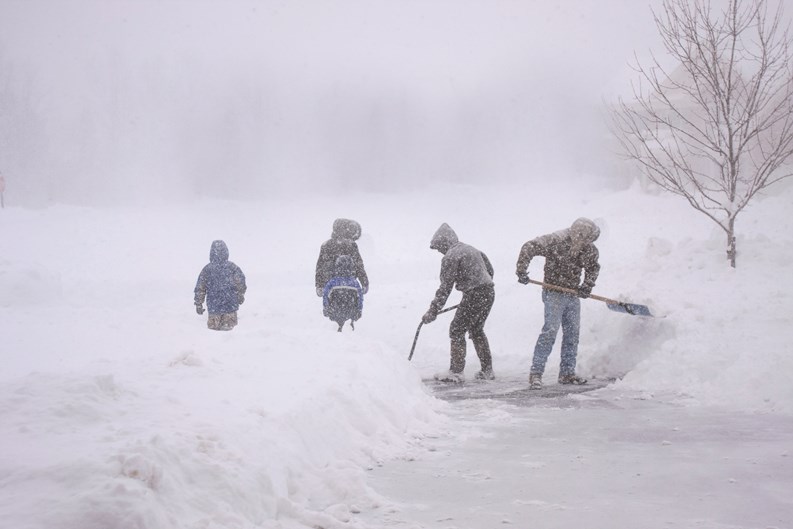The contractors who helped dig out the region’s condo properties last winter agree on one thing—the associations that were ‘rescued’ first were the ones that had solid relationships with their snow and ice removal contractors.
They also planned ahead. “I would start looking in September, at the latest October, because it takes about a month to get ready for a site and have the everyone know what they’re doing once there,” says Mike Smith of Snow Pros of New York.
“You should do a walk through and have a detailed plan in place before the snow starts. We have weekly safety meetings with employees since safety is a big issue with the snow. We go over what went wrong and what went right and how to fix what went wrong next time because everything is a learning experience at each site,” Smith adds.
“People don’t like to have the expense. Snow removal isn’t something like construction or landscaping where there’s something concrete after you’ve paid, but it’s still important because it helps you avoid slip and falls or an accident. Every year there are fatalities due to winter weather and to have that snow and ice managed with a professional company goes a long way toward justifying the expense,” says Martin Tirado of the Snow & Ice Management Association, a non-profit trade group that represents the snow and ice removal industry.
Tirado contends that a lot of people underestimate winter weather and that it can be just as dangerous as any other kind of major storm. “Winter weather is unpredictable and it’s an emergency service,” he says. “When people are stuck in places or they can’t get to school or work or out of their houses and that’s when emergency situations can arise and our members take that very seriously and try to perform professional services and get the slow and ice cleared. We need to be aware, though, that having bare pavement at all times is impossible and that we all need to be careful when walking or biking.”
Frank Schembre, president of Executive Snow Control in New York, notes that it could take a few interviews before you find a contractor that works for you. “Something to look for when selecting a service provider is to make sure that they can meet whatever unusual demands that the season produces.”
For those that have never had a provider before, Tirado suggests that they start looking even earlier. “For those who are looking for a provider, but have never had one before should start looking in the summer,” he says. “From the perspective of a provider it’s a combination of personnel needed, equipment needed, salt and other de-icing materials necessary to purchase in advance to have available to service their customers and if they aren’t already, their resources will essentially be sold out.”
Dealing with Ice and Preventing Damage
“All customers have difference tolerance levels when it comes to snow, so what we try to do is learn what their tolerance level is,” says Schembre.
“It’s a very specialty kind of work as it’s relentless; you’re fighting Mother Nature, so it’s not an easy job, Smith adds.
When it comes to taking care of ice, there are a number of different products that can be used. Many of them are more environmentally friendly than just plain old rock salt.
“There are a number of customers that want calcium chloride so we’ll use that instead of rock salt,” says Schembre, adding that when it comes to de-icing liquids, “We don’t specifically use some of the liquids because we find some can be slippery, but most liquids work at lower temperatures than rock salt.”
According to Smith, “Salt can hurt the landscape and rivers and streams, so we try to use it very cautiously. We try to use calcium where people are walking because it’s not as hard of a material, anywhere that people are standing or walking on we don’t use rock salt. The problem with calcium is that it’s expensive so people use magnesium or an ice melter.”
“More service providers are being more aware and sophisticated with how much salt they are applying and there is this right balance of how much is enough,” says Tirado. “A lot of times the answer isn’t just to keep applying rock salt because if it gets too cold it can become ineffective and it can kill vegetation come spring time and it’s environmentally harmful. When property owners are talking to their service providers they should have a talk about what the appropriate amount of application is. The cost of salt has escalated after the big winter storms of the last year and the best way to ensure against the price fluctuations is to only use what is needed to get the job done.”
He adds that one of the best ways to prevent damage to common areas is, “to have some absorbent mats people can brush their shoes and boots on. Making sure to cover all the high traffic areas, the entrances and exits for example, is important.”
Too Much Snow?
Finding contractors to clear snow and ice is one challenge; the next step is removing snow when a property is short on space, as in urban neighborhoods. Aside from trucking the snow piles away, some property managers discovered an even more efficient solution last winter—turn it directly into water.
“If it’s a very heavy winter,” says Smith, “and we get back-to-back snowstorms we’ll plan for it. If it looks like there’s a lot of snow on the ground and it looks like we’ll be getting another snow shortly then we come in with machines and relocate it somewhere. If there’s space on the property we’ll just move it there, but there isn’t we’ll remove it from the site.”
“What we’ll do is literally remove the snow from our customer’s property and move it to a snow storage facility that we have in either Maspeth or Long Island depending on the quantity of snow that needs to be removed and the time of the removal. We had to do that for the last two years. Keep in mind that not all snow and ice managers have that availability,” says Schembre.
Liability
When it comes to making certain your building or community has done its duty in terms of snow and ice control, “You could be liable anywhere,” says Tirado. “We’ve seen some cases against service providers or property managers where someone walks into a building's common area with snow or ice on their boots, and because of the wetness they slip and fall. They can say that part of that was because...the exterior surfaces [weren't cleared], or because of not having mats inside for traction.”
While the standards vary from state to state, across the country either building owners or service providers could be held accountable for slip and falls. “Anywhere there is the potential of a slip-and-fall, there is the potential for litigation and for someone to sue a service provider or a property owner,” Tirado continues. “What it can do is really drive up the insurance costs, especially if they have claims.”
Preparing for the Winter
When it comes down to it, preparing for the winter months starts well in advance. It isn’t enough to just hire a company to take care of the snow. There are logistical issues they need to consider when planning out how to take care of properties.
“At the beginning of the season, the importance to be is to make sure all cracks are filled, all broken surfaces are repaired. Make sure all gutters and water drainage is in repair. Leaky gutters and leaders that come down from the roof, that don’t drain, can cause problems, says Schembre.
He adds that, “Shading is also an issue, when there’s snow and ice in an area that doesn’t get sun we have to watch for that. Another is thawing and refreezing of snow, where the temperature goes to above freezing during the day and then back down at night, freezing the melted snow and ice; the following morning that water could turn back to ice and contributes to unsafe conditions.”
“We start in September, getting equipment ready and the maintenance; we also start our proposals early. As a snow only company we try to get people to sign up earlier instead of later so we don’t need to scramble as there is a lot of preparation when it comes to setting up larger sites: they have to marked out, you have to dump salt, you have to go over every little thing like where the snow gets pushed and where it doesn’t, there’s a lot of detail work,” says Smith.
While there may not be a lot of, or any, snow this winter, making sure there is someone ready to dig out your property is important as storms can sneak up and catch you unaware.
“People don’t like to have the expense,” says Tirado in conclusion. “Snow removal isn’t something like construction or landscaping where there’s something concrete after you’ve paid, but it’s still important because it helps you avoid slip and falls or an accident. Every year there are fatalities due to winter weather and to have that [snow and ice] managed with a professional company goes a long way toward justifying the expense.”
John Zurz is a staff writer with The Cooperator. Freelance writer Marie Auger also contributed to this article.










Leave a Comment